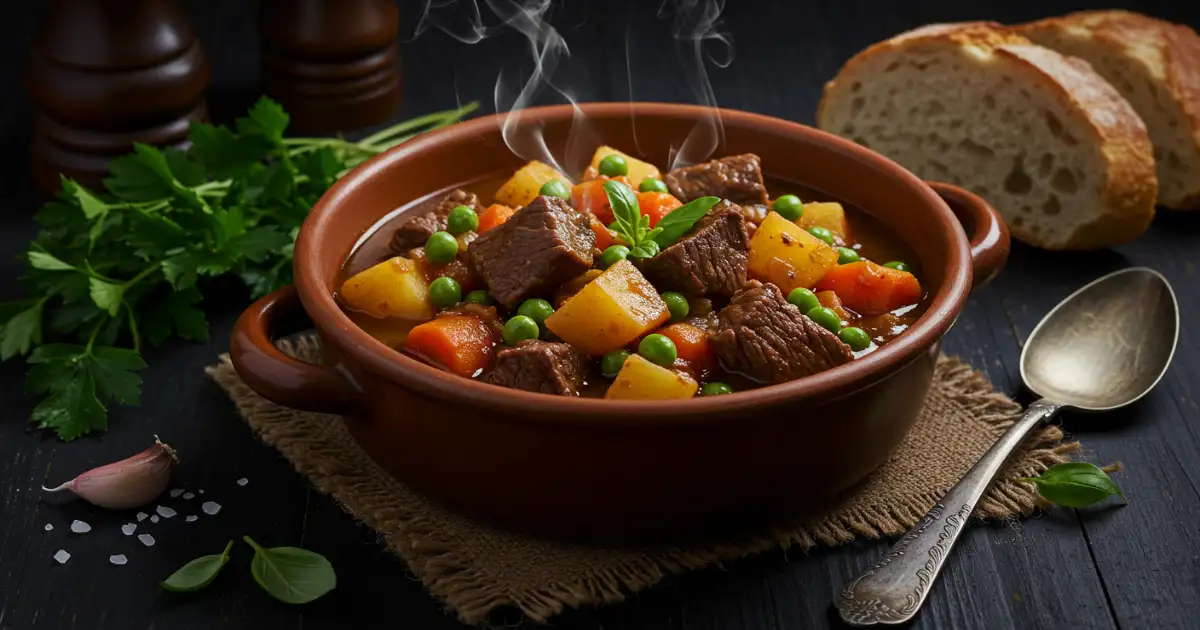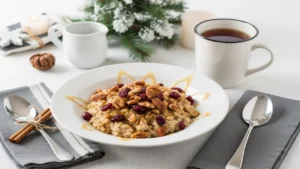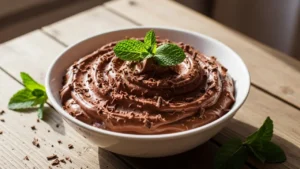You know the feeling — a gray afternoon, a door that opens to the smell of warm broth and slow-cooked comfort. You want a simple plan that rewards you with deep flavor and a pot that waits for you when the day ends.
Start by searing the meat in a hot pan with a little olive oil; those browned bits make a richer final dish. Load the slow cooker after you sauté aromatics so the ingredients marry while you go about your day.
Stir peas in during the last few minutes for color and sweetness. Rely on potato starch for body or finish with a quick cornstarch slurry boiled 1–2 minutes to set the texture.
Plan to freeze portions in freezer bags and serve over mashed potatoes or with rolls for a full meal. This recipe gives you repeatable steps to build layered taste, whether you add wine, tomato paste, or a splash of Worcestershire for extra umami.

Slow Cooker Beef Stew
Equipment
- Dutch oven or heavy skillet
- Slow cooker (6–7 qt)
- Wooden or silicone spoon
- Measuring Cups
- Sharp knife and cutting board
Ingredients
- 2 lb boneless chuck roast, cut into 1.5-inch pieces
- 2 tbsp olive oil
- 1 large onion, chopped
- 3 cloves garlic, minced
- 2 tbsp tomato paste
- 1 cup red wine or beef broth
- 4 cups low-sodium beef broth
- 4 carrots, cut into chunks
- 3 celery stalks, chopped
- 3 medium potatoes, diced
- 1 cup frozen peas
- 2 bay leaves
- 1 tsp dried thyme
- 1 tbsp Worcestershire sauce (optional)
- Salt and pepper, to taste
- Cornstarch slurry (1 tbsp cornstarch + 1 tbsp cold water)
Instructions
- Pat meat dry and sear in batches in olive oil over medium heat until browned on all sides. Do not overcrowd the pan.
- Remove beef and add chopped onion to the pot. Sauté until softened, then stir in garlic and tomato paste and cook 1–2 minutes more.
- Deglaze the pot with red wine or broth, scraping up the fond from the bottom of the pan.
- Transfer seared beef and sautéed aromatics into the slow cooker. Add carrots, celery, thyme, bay leaves, and remaining broth. Add enough liquid to just cover the contents.
- Cook on LOW for 7–8 hours or HIGH for 4–5 hours until beef is fork-tender.
- Add diced potatoes during the last 2 hours of cooking. Stir in peas during the final 10 minutes.
- To thicken, mix cornstarch slurry and stir into simmering stew. Let boil for 1–2 minutes until thickened.
- Taste and adjust salt, pepper, or acidity with broth or vinegar before serving. Let rest a few minutes before ladling into bowls.
Notes
Nutrition
Table of Contents
Why You’ll Love This Slow Cooker Beef Stew Right Now
Let the slow cooker do the heavy lifting while you get on with your day. This recipe gives you true comfort food with minimal fuss. Spend a few minutes searing and sautéing, then transfer everything to the cooker to finish on low.
Comfort food that’s largely hands-off
You set it and let a gentle simmer do the work for about 4–5 hours after searing. The low heat breaks down connective tissue so the meat becomes fork-tender without drying out.
Meltingly tender meat with rich, balanced flavor
Browned bits, tomato paste, and herbs build depth so the pot tastes layered and rounded. Add peas in the last few minutes so they stay bright and sweet.
- Taste and adjust salt and pepper near the end for balance.
- Make ahead—the flavors deepen after resting overnight.
- Flexible timing: the moist heat keeps results forgiving if plans shift.
Beef Stew Ingredients You’ll Need
Gathering the right pantry and produce makes the rest of the recipe easier.
Choose your meat carefully. Pick boneless chuck with visible marbling and connective tissue so it becomes fork-tender. Avoid mixed, lean stew meat that can dry out during long cooking.
Vegetables that hold up
Use sturdy potatoes and carrots for body and sweetness. Add celery and onion for savory balance.
Peas should be stirred in during the last few minutes to stay bright and fresh.
Flavor boosters and pantry essentials
- Low-sodium beef broth to control seasoning and depth.
- Red wine or a splash of balsamic for acidity; extra broth works if you skip wine.
- Tomato paste, garlic, thyme, and bay leaves to build savory layers.
- Olive oil for searing and a light flour dredge or cornstarch slurry to thicken the liquid.
- Season in stages with salt and pepper, tasting near the end.
Prep ingredients in even pieces so everything finishes at the same time. A small flour coating on the meat adds body, while potato starch from the spuds helps thicken the broth naturally as it cooks.
Step-by-Step: How to Make It in the Slow Cooker
Follow a few focused steps on the stovetop and the slow cooker will do the rest. To build deep flavor, work in small batches so every piece gets a proper sear.
Sear in batches for deeper flavor (optional but recommended)
Pat the meat dry and heat a little oil in a dutch oven or large dutch oven over medium heat.
Sear in batches to avoid crowding the pan; that crust and the browned bits on the bottom are concentrated flavor.
Deglaze to capture the fond
Add add onions to soften, stir in garlic and tomato paste, then pour a cup of red wine or broth.
Scrape the bottom to dissolve the fond. This liquid becomes the backbone of the pot.
Layer and load the slow cooker
Transfer everything to the slow cooker, then add beef with any juices and herbs.
Layer carrots and celery around the meat and add enough broth or water to barely cover.
When to add potatoes and peas for perfect texture
Cook on high for about 4–5 hours (or 7–8 hours on low) until fork-tender.
Add potatoes during the last 1–2 hours and stir in peas for the final 5–10 minutes.
“Let the pot rest briefly before serving so flavors meld and the broth tightens.”
Beef Stew Thickening Methods
Finish the pot with a simple thickening method that keeps the broth glossy and spoonable. Choose an approach based on time, tools, and whether you want a flour-free finish.
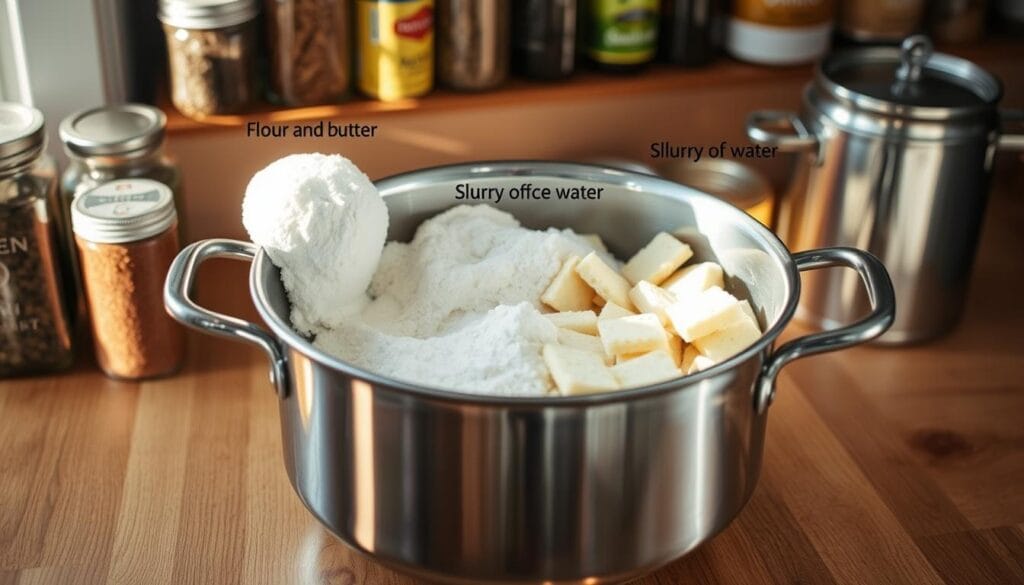
Cornstarch slurry for glossy body
Mix equal parts cornstarch and water to form a smooth slurry. Stir it into boiling liquid and let the pot boil 1-2 minutes to remove any starchy taste.
Natural thickening from potato starch
If you prefer no added thickeners, rely on diced potatoes. Their starches will slowly blend into the broth and create a velvety mouthfeel as the dish cooks.
Butter-flour paste as a stovetop finish
Make a beurre manié by kneading equal parts softened butter and flour. Whisk small bits into a simmering pot to adjust viscosity without lumps.
- Dredge meat lightly in flour before searing for subtle body as it cooks.
- Add thickeners slowly, wait a minute, then reassess to avoid over-thickening.
- Keep acidity from tomato elements in mind and balance with salt so the finished stew tastes bright and rounded.
“Aim for a sheen that coats meat and vegetables without masking texture.”
Tips for Tender, Flavorful Meat
Choose a well-marbled cut and let its fat and collagen work for you over low heat. A chuck with visible marbling will render fat and break down to a fork-soft bite as it cooks slowly.
Choose and prep wisely
Cut pieces evenly so every cube finishes at the same time. Trim excess but keep enough fat to flavor the sauce and protect the meat during long cooking.
Sear smart, cook gentle
Sear in batches to avoid crowding. Crowding traps steam and prevents browning, which limits flavor development.
Then use low, steady heat. High temperatures can seize proteins and make the meat tough instead of tender.
Finish and season
Avoid lifting the lid often; steady conditions help the beef tender as collagen melts. Test doneness when a fork slides in with little resistance.
Season in layers and taste late. A final pass of salt pepper and a splash of broth or wine will brighten the pot without oversalting early.
| Action | Why it matters | Quick tip |
|---|---|---|
| Select chuck | Fat and connective tissue render into silky texture | Look for visible marbling |
| Sear in batches | Develops fond; avoids steaming | Work in 2–3 small batches |
| Low, gentle heat | Breaks down collagen without toughening | Cook on low or gentle simmer |
Beef Stew Variations and Substitutions
Choose a direction—classic French richness or a simple, no-alcohol approach—before you build the pot. That decision shapes liquids, herbs, and timing so your final dish hits the texture and flavor you want.
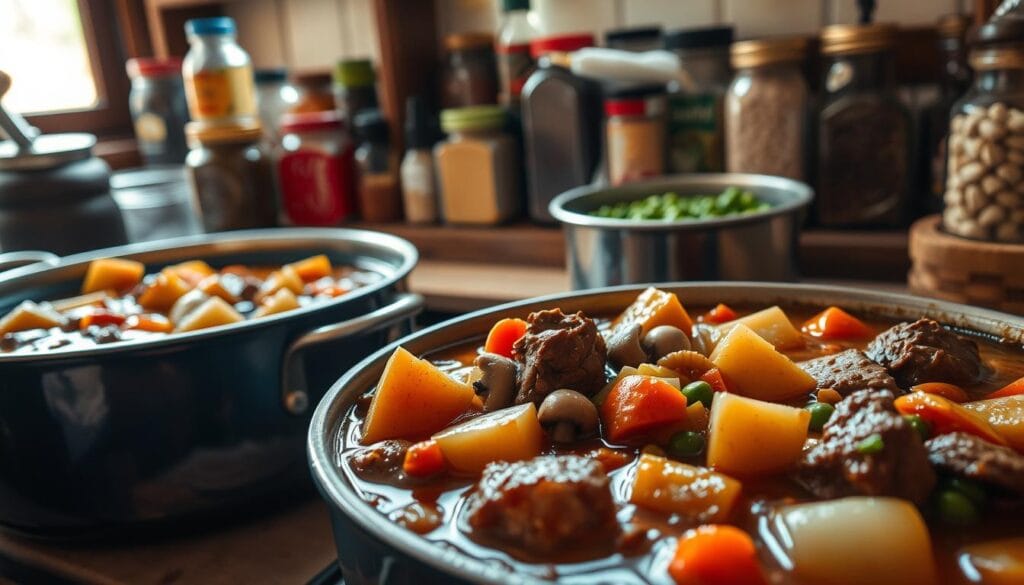
Wine-forward French-style braise
Layer red wine with tomato paste, garlic, thyme, and bay for a deeply savory sauce. Sear, deglaze, then braise low and slow for about 2 hours, add vegetables, and cook another hour.
No-wine option
Skip alcohol by adding extra beef broth and a splash of Worcestershire. The liquid combo keeps umami and acidity so your stew recipe still tastes rich and balanced.
Instant Pot and stovetop adaptations
For pressure cooking, sear on Sauté, deglaze, then pressure-cook the meat and aromatics. Add potatoes later and finish on Sauté to control doneness.
To braise on the stove, cover and simmer on low, stirring occasionally to prevent sticking. Adjust water and broth so liquid stays at or just below solids.
“Finish with a beurre manié or a handful of parsley to lift the sauce and round the flavor.”
- Tweak aromatics—balsamic with onions adds sweet acidity.
- Swap parsnips or mushrooms for variety; add potatoes late.
- Scale up by searing in batches to protect flavor for crowds.
Main Keyword: Beef Stew
Dry and season first. Drying and salting the cubes before they hit the pan gives you a savory foundation that carries through the pot. A good crust adds instant flavor.
Sear in batches so the pan stays hot. Work in small groups to build fond rather than steam the meat. After browning, sauté onion and garlic until soft, then stir in tomato paste and toast briefly for color and depth.
Deglaze with a splash of red wine or broth, scraping up browned bits to enrich the broth. Keep liquid modest—just enough to surround the solids—so the pot concentrates instead of becoming a thin soup.
Tuck in bay and thyme and cook low and slow. Add potatoes with about 1–2 minutes of extra time left that matches their size, and stir in peas at the very end so they stay bright.
“Taste and adjust at the finish; a final splash of acid or a pinch of salt lifts the whole dish.”
| Step | Why it matters | Quick tip |
|---|---|---|
| Dry & season | Promotes browning for deep flavor | Pat pieces dry and salt 10 minutes before searing |
| Sear in batches | Builds fond; avoids steaming | Use hot pan and work quickly |
| Deglaze & simmer | Captures browned bits in the broth | Use red wine or extra broth, scrape bottom well |
| Add veggies last | Preserves texture and color | Potatoes earlier, peas in final minutes |
Equipment Notes: Slow Cooker, Dutch Oven, and More
A heavy, enameled pot gives you the best sear and an easy transfer into the cooker for hands-off finishing.
Use a dutch oven or a large dutch oven to brown meat and build fond before moving ingredients to the slow cooker. Browning works best in a heavy vessel because it holds steady heat.
Heat a thin film of oil until it shimmers, sear until browned, then lower the heat to sauté aromatics without burning. That step concentrates flavor and protects the pot surface.
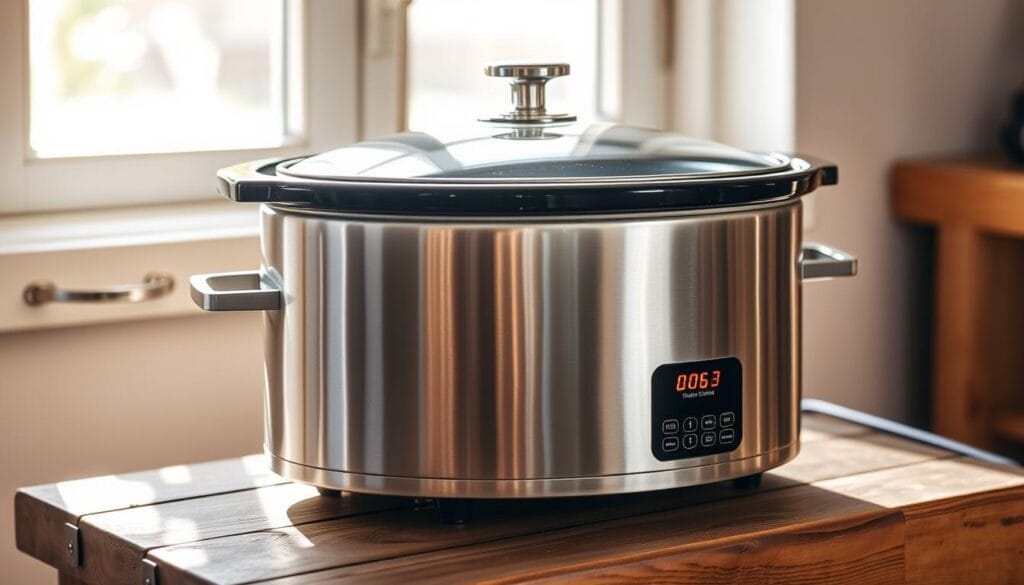
Choose a cooker that leaves an inch or two of headroom so circulation is even. Keep lids snug on both pot and cooker to hold moisture and steady temperature.
- Measure liquids carefully—often a few cups beef broth will suffice; keep liquid just to cover.
- Consider an oven braise at 325°F for a one-pot route: 2 hours, then add vegetables for about 1 hour more.
- Use wooden or silicone tools to scrape fond and protect enamel while deglazing.
“Check for a gentle simmer rather than a boil; hard bubbling dries meat and clouds the broth.”
Keep a ladle and a heat-safe measuring cup handy to skim or adjust liquids. Pre-warm serving bowls so your finished Beef Stew stays hot at the table without over-reducing on the stove.
Make-Ahead, Storage, and Freezer Instructions
Plan ahead and you’ll save time while keeping great flavor. Cool the pot quickly by transferring into shallow containers so the mixture drops below unsafe temperatures fast. This helps texture and food safety.
Chill safely and reheat gently
Cool to room temperature within two hours, then refrigerate up to 3 days. Use shallow pans to speed cooling and label with the date.
When reheating, warm over medium-low and stir every few minutes so vegetables don’t break down. If the sauce is too thick, refresh with a cup or a few tablespoons of beef broth or water.
Taste after warming and adjust salt and pepper before serving. Avoid long, high-heat finishes that toughen meat or mush vegetables.
Portion and freeze for easy meals
Portion into airtight containers or freezer bags and freeze up to 3 months. Thaw overnight in the fridge, then reheat covered to trap moisture.
Freeze single servings for quick lunches and stop reheating once steaming hot. Stir in a few cups less or a splash when needed so the texture matches your favorite recipes.
“Make it a day ahead—this dish often tastes better after the flavors meld.”
How to Serve Beef Stew
Serve the pot in warmed bowls so the sauce stays glossy and every bite feels cozy. Ladle hot portions over a base that soaks up the liquid and balances the rich flavors.
Ladle over mashed potatoes, egg noodles, or creamy polenta. Mashed potatoes give a classic, comforting bed. Egg noodles add a silky bite. Polenta creates a slightly sweet, creamy contrast.
Pairings that finish the plate
Serve warmed bowls of meat and vegetables first, then spoon extra broth so every serving has a good meat-to-gravy ratio.
- Pass crusty bread, popovers, or garlic crescent rolls to mop up sauce.
- Brighten plates with a simple arugula or mixed greens salad dressed lightly.
- Garnish each bowl with chopped parsley and adjust salt and pepper just before serving.
Portioning and timing
Plan about a cup and a half per person as a guideline so sides can round out the meal. Serve hot but not boiling; let the pot rest a few minutes so peas stay bright and tender.
“A splash of vinegar or a squeeze of lemon at the table will lift the savory profile and keep each bite lively.”
Conclusion
A final taste and a brief rest turn good ingredients into a memorable meal.
Sear in batches to build fond, then deglaze the pan so every browned bit makes it into the pot. Stir in tomato paste with onion and garlic, add thyme and bay leaves, and a splash of red wine or broth for depth.
Time vegetables so carrots soften, potatoes keep shape, and peas stay bright. Thicken with a cornstarch slurry or a flour-butter paste, or let potato starch do the work for a natural body.
Season near the end with salt pepper, portion by the cup, refrigerate for a few days, or freeze for months. You now have a dependable beef stew recipe to make again and again.
FAQ
What cut of meat should you use in a slow cooker for best results?
Do you need to sear the meat before adding it to the slow cooker?
When should you add potatoes and peas so they don’t become mushy?
How do you thicken the cooking liquid without losing flavor?
Can you make a no-wine version that still tastes rich?
How long should you cook the stew on low versus high?
What are good side dishes to serve with this hearty meal?
How do you store and reheat leftovers safely?
Can you adapt this recipe for an Instant Pot or stovetop braise?
What pantry staples and flavor boosters should you keep on hand?
“Want a peek into our daily kitchen life? Join us on Facebook.” for behind-the-scenes moments and more!”

